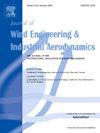Efficient prediction of unsteady piston winds in subway tunnels based on machine learning
IF 4.9
2区 工程技术
Q1 ENGINEERING, CIVIL
Journal of Wind Engineering and Industrial Aerodynamics
Pub Date : 2025-04-21
DOI:10.1016/j.jweia.2025.106111
引用次数: 0
Abstract
In emergencies such as fires in subway tunnels, the rapid prediction of piston winds therein is needed to provide theoretical guidance for emergency decision-making and fire rescue. Previous research has neglected the efficiency of piston wind prediction. For this reason, to improve on traditional methods, this paper uses eight different machine learning algorithms, including support vector regression (SVR), k-nearest neighbors (KNN), and extreme gradient boosting (XGBoost) et al., to construct a fast prediction model for unsteady piston winds in subway tunnels. A relatively optimal machine learning algorithm was determined through various evaluation methods, and feature importance analysis was carried out. The results show that it is feasible to utilize a machine-learning method for the fast prediction of unsteady piston winds in subway tunnels. The RF algorithm had a high prediction accuracy for unsteady piston winds, and the Mean Absolute Error (MAE), Root Mean Squared Error (RMSE), Symmetric Mean Absolute Percentage Error (SMAPE), and Coefficient of Determination (R2) of the prediction results were 0.04, 0.05, 1.15 %, and 0.995, respectively. The influence degree of each factor on the subway tunnel piston wind, in descending order, is as follows: time t>blockage ratio β>train running speed u>tunnel length ltu>train length ltr.
基于机器学习的地铁隧道非定常活塞风的有效预测
在地铁隧道火灾等突发事件中,需要对其中活塞风进行快速预测,为应急决策和火灾救援提供理论指导。以往的研究忽略了活塞风的预测效率。为此,为了对传统方法进行改进,本文采用了支持向量回归(SVR)、k近邻(KNN)、极限梯度增强(XGBoost)等8种不同的机器学习算法,构建了地铁隧道非稳态活塞风的快速预测模型。通过各种评价方法确定相对最优的机器学习算法,并进行特征重要性分析。结果表明,利用机器学习方法对地铁隧道非定常活塞风进行快速预测是可行的。该算法对非定常柱塞风具有较高的预测精度,预测结果的平均绝对误差(MAE)、均方根误差(RMSE)、对称平均绝对百分比误差(SMAPE)和决定系数(R2)分别为0.04、0.05、1.15%和0.995。各因素对地铁隧道活塞风的影响程度由大到小依次为:时间t>;堵塞比β>;列车运行速度u>;隧道长度ltu>;列车长度ltr。
本文章由计算机程序翻译,如有差异,请以英文原文为准。
求助全文
约1分钟内获得全文
求助全文
来源期刊
CiteScore
8.90
自引率
22.90%
发文量
306
审稿时长
4.4 months
期刊介绍:
The objective of the journal is to provide a means for the publication and interchange of information, on an international basis, on all those aspects of wind engineering that are included in the activities of the International Association for Wind Engineering http://www.iawe.org/. These are: social and economic impact of wind effects; wind characteristics and structure, local wind environments, wind loads and structural response, diffusion, pollutant dispersion and matter transport, wind effects on building heat loss and ventilation, wind effects on transport systems, aerodynamic aspects of wind energy generation, and codification of wind effects.
Papers on these subjects describing full-scale measurements, wind-tunnel simulation studies, computational or theoretical methods are published, as well as papers dealing with the development of techniques and apparatus for wind engineering experiments.

 求助内容:
求助内容: 应助结果提醒方式:
应助结果提醒方式:


